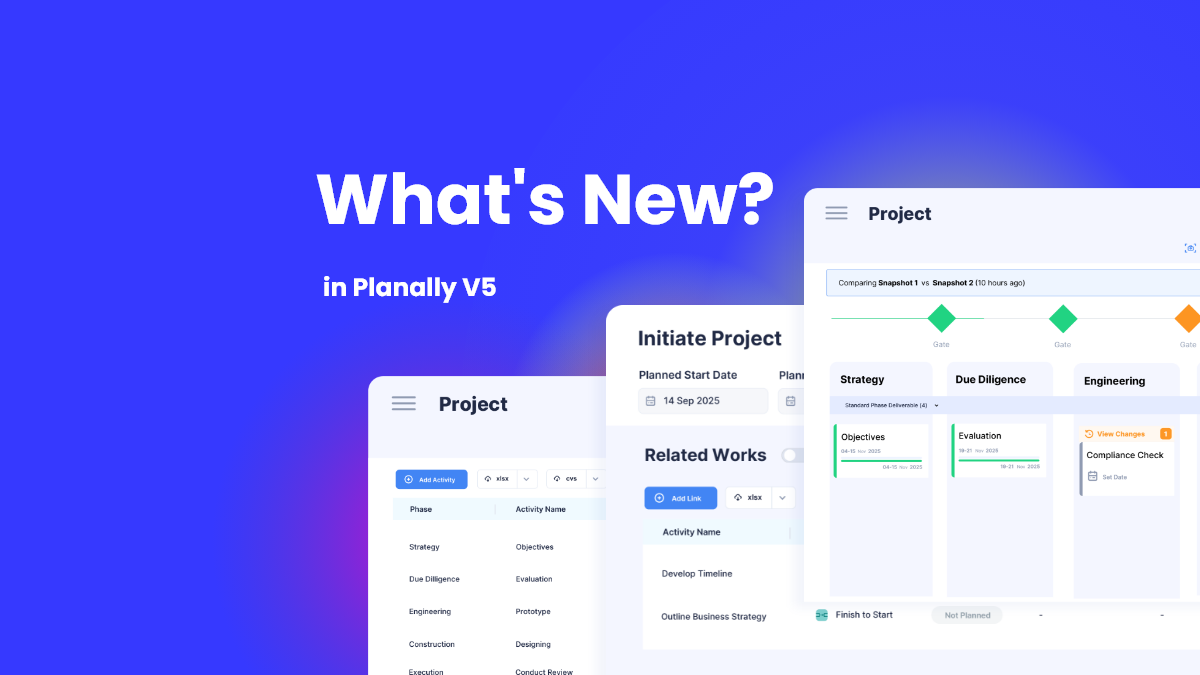Introduction: The Complexity Behind Contracts
Contract management is no longer a back-office function—it’s now a strategic pillar for organizations navigating tighter compliance regulations, complex vendor relationships, and accelerated business cycles. A single missed clause, delayed signature, or untracked obligation can trigger financial risk, legal exposure, and operational delays.
Traditional contract workflows, however, remain fragmented. Emails, spreadsheets, and shared folders dominate the process, leading to inconsistent approvals, poor version control, and minimal visibility. According to McKinsey, poor contract management can cost companies up to 9% of their annual revenue due to missed savings, compliance issues, and inefficient renewals.
That’s where structured workflows come in. A clear, repeatable framework ensures contracts are created, reviewed, approved, and executed with full accountability—minimizing risk and eliminating guesswork.
The Phase-Gate methodology, long used in product development and engineering, offers a smart solution. By dividing the contract lifecycle into defined phases with decision checkpoints (gates), teams can track progress, enforce compliance, and ensure contracts don’t move forward until key criteria are met.
Pair this with Planally, a no-code workflow automation platform, and the result is a complete contract management system—automated, standardized, and fully visible from request to renewal. No code. No chaos. Just smarter contract control.
What is the Phase-Gate Approach to Contract Management?
The Phase-Gate approach is a structured methodology that breaks down a process into sequential phases, each separated by a gate or checkpoint. At each gate, decision-makers assess whether the process has met specific criteria and decide whether to proceed, pause, or revise. This method was first developed to manage complex R&D and product development pipelines, where discipline, accountability, and iterative approvals are essential.
In contract management, this model fits naturally. Contracts move through multiple stages—request, drafting, review, negotiation, signature, compliance, and renewal. Applying a phase-gate lens ensures that each stage is completed rigorously, and no step is skipped or rushed.
Each gate acts as a quality control point—a smart pause that asks: Is this contract complete, compliant, and ready to move forward?
This approach has been shown to enhance performance across industries. According to a study by Harvard Business Review, structured stage-gate models improve project outcomes by reinforcing alignment, reducing risk, and ensuring critical checkpoints are not overlooked.
Planally takes this concept further by automating the gate logic—assigning tasks, triggering approvals, and ensuring compliance checks are baked into each phase. This transforms what was once a manual, error-prone process into a digital, auditable workflow that runs with precision.
By integrating the Phase-Gate methodology into your contract management strategy, you’re not just organizing documents—you’re enforcing discipline, accelerating approvals, and building a scalable process that grows with your business.
From Chaos to Clarity: The 6 Phases of Contract Management (With Gates)
Modern contract management isn’t just about drafting agreements—it’s about managing risk, ensuring compliance, and moving with speed. The Phase-Gate approach breaks the contract lifecycle into six clear phases, each with a gate—a decision point that must be met before advancing. This model helps teams avoid oversights, enforce accountability, and keep every contract moving in the right direction.
 Here’s how the Phase-Gate Contract Management Lifecycle works—and how Planally brings it to life with no-code workflow automation.
Here’s how the Phase-Gate Contract Management Lifecycle works—and how Planally brings it to life with no-code workflow automation.
Gate 0: Identifying the Contract Need
Key Activities:
- Identify the business need behind the contract
- Document internal stakeholders and departments involved
Gate Criteria:
- Business case validated
- Stakeholders formally logged
- Contract need approved for intake
Planally in Action:
Planally’s workflow templates let teams log contract needs with full context. By centralizing early-stage requests and stakeholder details in a structured, searchable format, Planally helps organizations build clarity from the start—before any contract work begins.
Phase 1: Contract Request & Intake
Key Activities:
- Submit standardized contract request
- Categorize contract type (NDA, MSA, SOW, etc.)
- Assign internal ownership
Gate 1: Justification & Completeness Review
- Legal or procurement verifies completeness
- Business justification validated
- Approved to move to drafting
Planally in Action:
With custom forms, auto-routing, and reminder triggers, Planally ensures that every contract request is properly categorized, assigned, and reviewed on time. Stakeholders are never left guessing about next steps or responsibilities.
Phase 2: Drafting & Internal Approval
Key Activities:
- Draft the contract using templates or from scratch
- Insert required clauses and obligations
- Collaborate with legal and internal teams
Gate 2: Risk & Review Gate
- Legal performs a compliance check
- Risk exposure is assessed
- Internal stakeholders sign off before external sharing
Planally in Action:
Planally’s workflow visualization tools provide real-time insight into which stage each contract is in. Teams can collaborate on drafts directly within the platform, add comments, and create task dependencies that block the next phase until internal approval is complete.
Phase 3: Negotiation & Finalization
Key Activities:
- Share draft with the external counterparty
- Exchange redlines and suggestions
- Maintain version control and negotiation log
Gate 3: Final Terms Approval
- Legal and executive team sign off
- All changes finalized and agreed upon
- Green light for execution
Planally in Action:
Every document version and team discussion is recorded in Planally ensuring a complete negotiation history. Its approval automation capabilities streamline the sign-off process and eliminate last-minute email chains or confusion.
Phase 4: Signature & Execution
Key Activities:
- Route the final contract for signatures
- Verify signing authority
- Execute the contract
Gate 4: Execution Confirmation
- Confirm all parties have signed
- Notify stakeholders
- Launch post-signature tasks
Planally in Action:
Once all signatures are in, Planally marks the contract as executed, notifies relevant stakeholders, and triggers post-execution tasks—all automatically. Teams stay on the same page, and no one misses the start of compliance or delivery deadlines.
Phase 5: Post-Signature Monitoring
Key Activities:
- Store contract in a secure repository
- Track milestones, renewals, and obligations
- Monitor for compliance
Gate 5: Compliance Readiness
- Ensure contract is audit-ready
- Obligation tracking systems activated
- Process marked complete
Planally in Action:
Planally uses automated reminders, custom compliance workflows, and detailed audit logs to ensure that no obligation or renewal is missed. Teams can monitor performance, send renewal alerts, and prepare for internal or external audits—all from one interface.
Phase 6: Renewal or Closeout
Key Activities:
- Evaluate contract performance
- Decide on renewal, renegotiation, or closure
- Archive closed contracts
Gate 6: End-of-Life Review
- Final decision on continuation
- Lessons learned documented
- Contract archived
Planally in Action:
Whether it’s time to renew or retire a contract, Planally’s dynamic roadmap automates the end-of-life process. It guides stakeholders through evaluations and archives contracts with version history, making future audits or reactivations seamless.
The Planally Advantage: Phase-Gate Done Right
Bringing structure to contract management isn’t just about putting processes in place—it’s about making sure those processes move forward with clarity, speed, and accountability. That’s where Planally delivers measurable value. By pairing the phase-gate methodology with no-code workflow automation, Planally gives teams a framework that doesn’t just track contracts—it empowers them.
Each gate becomes a moment of clarity. Each phase becomes an opportunity for control. And each stakeholder stays aligned every step of the way.
 Comparison Table: How Planally Brings the Phase-Gate Framework to Life
Comparison Table: How Planally Brings the Phase-Gate Framework to Life
| Phase-Gate Principle | How Planally Supports It | Impact on Contract Management |
| Clear Phases | Visual workflows reflect each stage of the contract lifecycle | Eliminates ambiguity and improves process focus across legal, procurement, and business teams |
| Gate Reviews | Role-based approvals with pre-set rules ensure only validated contracts move forward | Strengthens governance and risk control through standardized checkpoints |
| Automation | Automated task routing and deadline reminders | Shortens contract cycle times and reduces manual follow-ups (McKinsey reports automation can reduce contract cycle times by up to 60%) |
| Visibility | Real-time status updates and centralized dashboards for each contract | Promotes transparency and proactive issue resolution, critical for enterprise contract management |
| Collaboration | In-task commenting and document version logs | Improves internal alignment and keeps all stakeholders on the same page—even across departments |
| Compliance | Full audit trails and activity tracking for every contract action | Supports regulatory compliance, governance audits, and post-signature monitoring (as recommended by Gartner’s 2024 contract lifecycle best practices) |
By aligning phase-gate thinking with Planally’s no-code platform, contract workflows are no longer fragmented or dependent on ad hoc manual steps. Instead, they become smart, scalable, and tightly governed systems—built for today’s speed and tomorrow’s complexity.
Conclusion: Build Contracts That Work as Smart as Your Strategy
In contract management, clarity and control are everything. The Phase-Gate approach delivers both—breaking the lifecycle into manageable, decision-driven stages that reduce risk, strengthen compliance, and improve cycle time. Each gate acts as a checkpoint, ensuring nothing slips through the cracks before moving forward. This structured framework not only protects your business—it empowers it.
But structure alone isn’t enough. Without the right tools, the phase-gate model can feel rigid, manual, and slow. That’s where Planally steps in.
As a no-code workflow automation platform, Planally brings agility and precision to every phase. From capturing contract needs and managing approvals to tracking obligations and triggering renewals, Planally enables seamless transitions across the lifecycle—all without writing a single line of code.
 By automating routine tasks, eliminating approval delays, and keeping every stakeholder in sync, Planally helps organizations:
By automating routine tasks, eliminating approval delays, and keeping every stakeholder in sync, Planally helps organizations:
- Accelerate contract turnaround times
- Ensure phase-by-phase accountability
- Maintain full visibility from request to renewal
Whether you’re managing five contracts or five thousand, the combination of a Phase-Gate framework and Planally’s automation engine turns a traditionally complex process into a streamlined, future-ready system. No clutter. No chaos. Just smart, scalable workflows—built to match the speed and strategy of modern business.
One Workflow. Every Contract. Total Control.
Contract management doesn’t have to be messy, manual, or misaligned. With Planally, you can transform every stage of the contract lifecycle—from intake to closeout—into a smart, structured, and automated process.
Whether you’re handling NDAs, MSAs, or complex vendor agreements, Planally’s no-code workflow automation gives your team the tools to standardize steps, enforce approvals, track compliance, and eliminate bottlenecks without the need for IT intervention.
Explore Planally and get started today!




